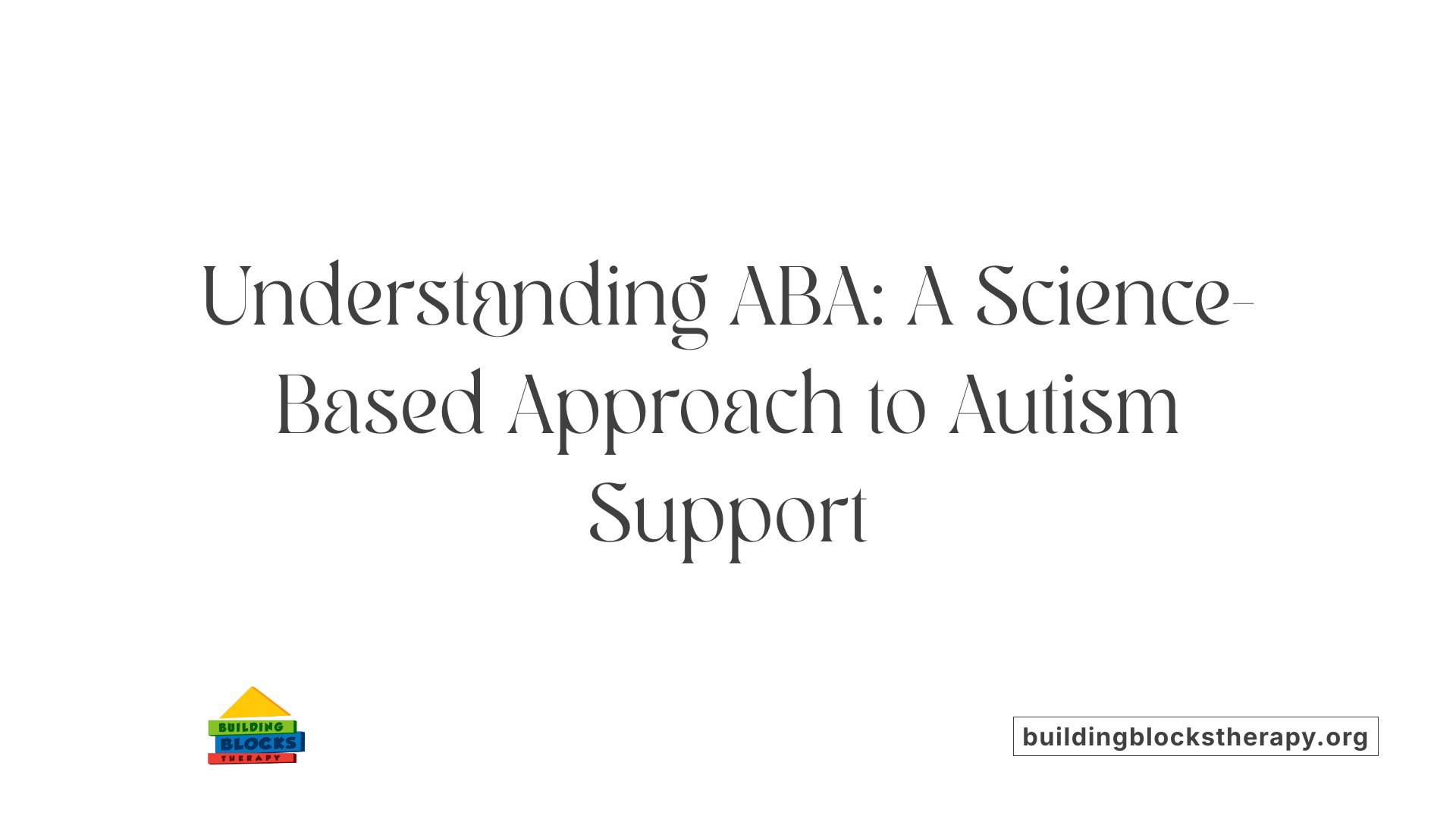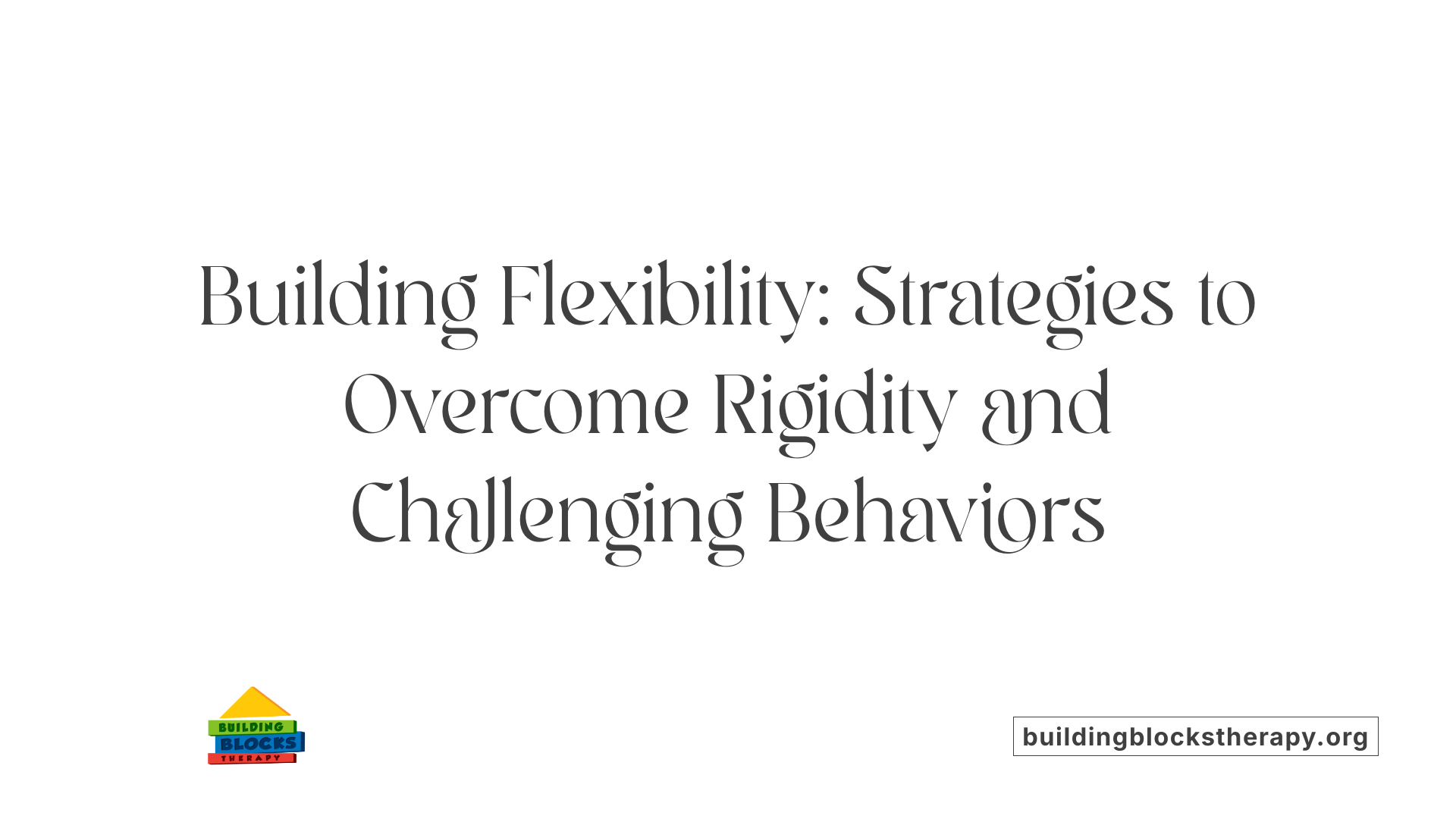Addressing Rigid Thinking in Autism
Exploring Behavioral Approaches to Manage Rigidity in Autism

Understanding Rigidity and Autism
Rigid thinking is a common challenge in individuals with autism spectrum disorder (ASD), often manifesting as inflexible behaviors, repetitive routines, and difficulty adapting to change. Addressing rigidity is crucial because it can impact daily functioning, learning, and social interactions. This article explores how evidence-based therapies, particularly Applied Behavior Analysis (ABA), provide strategies to support individuals with autism in developing flexibility, independence, and effective communication, enhancing their overall quality of life.
What is Applied Behavior Analysis (ABA) Therapy?

Definition of ABA therapy
Applied Behavior Analysis (ABA) is a therapy rooted in the scientific study of behavior. It aims to improve specific behaviors and skills by using reinforcement strategies. ABA is widely recognized as an evidence-based treatment for autism spectrum disorder (ASD), focusing on increasing positive behaviors and decreasing those that interfere with learning and daily function.
Historical background
Since its development in the 1960s, ABA has evolved as a standard approach for supporting children with autism. Early methods concentrated on structured learning sessions, while modern ABA integrates naturalistic, play-based techniques. This shift helps children generalize skills beyond therapy settings and supports their overall development.
Core principles and techniques
ABA relies on analyzing the context around behaviors using the ABCs framework: Antecedent (what happens before), Behavior (the action), and Consequence (the outcome). Techniques include positive reinforcement to promote desirable behaviors, extinction to reduce unwanted behaviors, and functional communication training to replace challenging behaviors with socially acceptable alternatives. Prevention strategies also play a role, using visual schedules or timers to make environments predictable and less stressful.
How ABA helps with rigidity in autism
ABA addresses rigidity — often seen as repetitive or inflexible behaviors in autism — by building new skills that enhance independence and flexibility. Instead of trying to change the child’s neurodiversity, ABA modifies environmental factors to shape behavior. Programs emphasize early intervention and focus on each child's strengths and interests, encouraging participation in social settings and maximizing happiness through individualized support.
ABA therapy typically involves 10–20 hours per week, administered by trained professionals, including behavioral analysts. Through these personalized, evidence-based methods, ABA helps individuals with autism improve communication, reduce harmful behaviors, and gain skills to navigate everyday life more successfully.
Who Provides ABA Therapy and Their Qualifications

Types of ABA Providers
ABA therapy is predominantly delivered by licensed and credentialed professionals specializing in behavioral analysis and autism spectrum disorder (ASD). The main providers include board-certified behavior analysts (BCBAs), board-certified assistant behavior analysts (BCaBAs), and trained therapists who have specialized knowledge in applied behavior analysis techniques. These individuals are responsible for assessing, designing, and overseeing individualized treatment plans.
Certification and Credentials Required
To ensure effective and ethical care, ABA providers typically hold certifications such as BCBA or BCaBA credentials. These certifications require rigorous training and examination, ensuring proficiency in various ABA methods, including discrete trial training and reinforcement strategies. Providers conduct thorough assessments like functional behavior assessments (FBAs) to identify behavioral triggers and target skills critical for intervention planning.
Importance of Specialized Training
Specialized training equips professionals to deliver evidence-based interventions that are individualized to the child’s needs and strengths. This training covers understanding the context of challenging behaviors and employing strategies such as prevention, replacement, and response. Modern ABA approaches emphasize naturalistic, play-based methods promoting skill generalization and child independence.
Role of Family and Caregiver Involvement
Family and caregivers play a crucial role in ABA therapy. Collaborative goal-setting and caregiver training ensure that interventions are consistent and effective across environments. This partnership helps maintain progress beyond therapy sessions and supports maximizing the child’s happiness and participation in society.
Access to ABA therapy generally requires a formal ASD diagnosis, and while insurance coverage can vary, many private and government programs provide financial support to obtain these crucial services.
Typical Goals and Methods in ABA Therapy
What are the typical goals and methods used in ABA therapy for autism?
ABA therapy aims to increase helpful behaviors, such as communication, social skills, independence, and academic abilities, while reducing challenging or harmful behaviors. These behavioral goals are carefully tailored to each individual's needs through comprehensive assessments. Each goal is designed to be SMART—specific, measurable, achievable, relevant, and time-bound—to ensure effective progress tracking.
The methods used in ABA are diverse and data-driven. Central to the approach is positive reinforcement, which encourages desired behaviors by immediately rewarding them. Techniques like discrete trial training and natural environment teaching are applied to promote learning both in structured settings and everyday situations. Modern ABA favors naturalistic, play-based strategies that help skills generalize beyond therapy sessions.
ABA also emphasizes reducing rigidity by building on a child's interests and strengths, encouraging flexibility and independence. Strategies involve understanding the context of behaviors, including antecedents and consequences, to inform interventions that fit the individual's unique profile.
Regular data collection and program evaluations by qualified behavior analysts (BCBAs) ensure that interventions stay aligned with evolving goals. This individualized and evidence-based approach supports meaningful skill development and positive behavior change, ultimately enhancing the quality of life for children with autism.
Assessment and Tailoring of ABA Interventions

What is the role of functional behavioral assessments (FBA)?
Functional behavioral assessments (FBA) serve as a foundational step in designing effective Applied Behavior Analysis (ABA) programs. The FBA aims to identify the specific environmental factors that trigger challenging behaviors in individuals with autism spectrum disorder (ASD). By understanding the reasons behind these behaviors, therapists can create interventions tailored to each child's unique needs and circumstances.
How are environmental triggers and behaviors analyzed?
In an FBA, professionals observe the context in which behaviors occur, noting antecedents (what happens before), behaviors themselves, and consequences (what happens after). This analysis helps clarify the purpose or function of the behavior, revealing whether it seeks attention, communication, avoidance, or sensory input. Recognizing these patterns is crucial for developing interventions that address root causes rather than just symptoms.
How are prevention, replacement, and response strategies customized?
Successful ABA interventions blend three types of strategies, customized based on the FBA findings:
Prevention strategies: These include making environments more predictable using visual schedules, timers, or priming before activities. Such measures reduce anxiety and the chance of challenging behaviors by minimizing uncertainty.
Replacement strategies: Functional communication training and teaching coping or daily living skills provide the child with socially appropriate ways to meet the same needs previously expressed through problem behaviors.
Response strategies: Techniques like positive reinforcement encourage desirable behaviors by immediately rewarding them, while extinction methods reduce attention to unwanted behaviors, lessening their frequency.
Why is ongoing monitoring important?
ABA interventions are dynamic; continuous monitoring ensures that strategies remain effective as the child grows and their needs evolve. Regular assessments allow practitioners to adjust interventions, build on strengths, and support greater independence, ensuring ABA therapy leads to meaningful, lasting improvements in behavior and quality of life.
Strategies to Address Rigid Thinking and Challenging Behaviors

Understanding Challenging Behaviors as Communication
Challenging behaviors in individuals with autism often stem from difficulties in communication. Recognizing these behaviors as expressions helps therapists and caregivers respond more effectively. Instead of viewing these behaviors as merely problematic, the focus is on deciphering the underlying message or need being conveyed.
Prevention Strategies: Creating Predictable Environments
Prevention techniques aim to reduce the occurrence of challenging behaviors by making environments more structured and less overwhelming. Tools such as visual schedules provide clear expectations for daily activities, while timers help manage transitions smoothly. Priming, or preparing individuals for upcoming tasks, and embedding less preferred tasks within enjoyable activities also help ease anxiety and resistance.
Replacement Strategies: Teaching Functional Alternatives
To equip individuals with more socially acceptable ways of expressing needs, replacement strategies are employed. Functional communication training teaches alternative ways to express desires or frustrations effectively. Additionally, developing coping skills and teaching daily living skills empower individuals to manage situations that previously triggered difficult behaviors.
Response Strategies: Reinforcing Positive Behavior
When challenging behaviors do occur, response strategies focus on shaping behavior through reinforcement. Positive reinforcement immediately rewards desired behaviors to increase their frequency. Conversely, extinction techniques involve strategically reducing attention to problem behaviors, which over time decreases their occurrence. Combining these strategies ensures a balanced approach to behavior modification.
These interventions are often customized through functional behavioral assessments, allowing professionals to combine prevention, replacement, and response strategies tailored to individual needs.
Measuring and Monitoring Effectiveness of ABA Therapy

How is the effectiveness of ABA therapy measured and monitored over time?
The effectiveness of Applied Behavior Analysis (ABA) therapy is systematically measured by collecting and analyzing precise behavioral data over time. Before starting therapy, therapists define clear and measurable behavioral objectives. These objectives focus on observable behaviors, such as frequency, duration, or intensity, ensuring that progress can be tracked accurately.
Data collection involves consistent and ongoing recording of these behaviors during therapy sessions. This data is then presented visually through graphs. Graphing allows therapists to identify trends, compare progress against baselines, and make informed decisions about the effectiveness of interventions. For instance, a decreasing trend in harmful behaviors alongside an increase in skill acquisition signals positive therapy outcomes.
Therapists often use experimental designs like reversal or alternating treatments within these data monitoring processes to further validate the effectiveness of specific interventions. Such methods help distinguish between changes due to therapy and those from other factors.
Another vital component is family communication and involvement. Therapists ensure that families understand the targeted behaviors, the methods used to measure progress, and how these data influence decision-making throughout treatment. Through regular updates and collaboration, families remain engaged partners in the therapy process, helping to support and generalize skill development beyond clinical settings.
Modern Approaches in ABA: Emphasizing Naturalistic and Person-Centered Therapy
How has ABA therapy shifted toward play-based and natural environment teaching?
Modern Applied Behavior Analysis (ABA) therapy has evolved from traditional, intensive programs toward more naturalistic and play-based approaches. Instead of relying solely on structured drills, therapists now integrate learning into everyday activities and play sessions, creating a more engaging and less intrusive setting. This shift helps children generalize skills beyond therapy, making it easier to apply what they learn in real-world situations.
How does ABA focus on building skills through individual interests and strengths?
Contemporary ABA promotes a person-centered approach by tailoring interventions to each child's unique strengths and interests. Therapists incorporate preferred activities and subjects to motivate learning, helping children develop essential skills in a fun and meaningful way. This method not only optimizes engagement but also fosters independence and social participation.
Why have therapy hours been reduced to more manageable levels?
Unlike older ABA programs that often required upwards of 40 hours per week, modern ABA typically involves 10 to 20 hours weekly. This reduction makes therapy more sustainable for families and children while still providing significant benefits. The emphasis is on quality and relevance of interaction rather than sheer quantity of hours.
How does modern ABA promote happiness and participation over normalization?
Today’s ABA practices prioritize enhancing the well-being and happiness of autistic individuals over attempting to make them conform to neurotypical standards. Therapy aims to empower children by improving communication, reducing distressing behaviors, and supporting meaningful participation in society. This respectful and supportive outlook helps preserve neurodiversity and celebrates each child’s uniqueness.
Criticisms and Controversies Surrounding ABA Therapy
Are there any criticisms or controversies surrounding ABA therapy in autism treatment?
Applied Behavior Analysis (ABA) therapy, despite being widely recognized and evidence-based, has faced various criticisms and controversies over time. Historically, some ABA programs employed aversive techniques, such as electric shocks and physical punishment, to reduce challenging behaviors. These methods have largely been discontinued and replaced by positive reinforcement and more humane strategies, reflecting an evolution in ethical standards.
Concerns have also been raised about the intensity and focus of early ABA protocols, which sometimes emphasized strict compliance and normalization of autistic behaviors. Critics argue this approach might neglect the unique preferences, strengths, and neurodiversity of individuals on the autism spectrum. In response, modern ABA therapies have shifted towards more flexible, naturalistic, and person-centered interventions that prioritize skill development and independence while respecting the child's identity.
Advocates from the autism rights movement stress the importance of respecting neurodiversity and caution against therapies that could be perceived as efforts to erase autistic traits. They highlight potential psychological impacts of ABA, such as trauma or mental health issues, although current scientific evidence has not firmly established direct causal links.
Current ethical considerations emphasize the need for personalized treatment, combining prevention, replacement, and response strategies based on careful assessment. Such approaches ensure that ABA therapy not only focuses on behavior change but also supports well-being, happiness, and meaningful participation in society without attempting to change an individual's inherent neurodiversity.
Early Intervention and Its Impact on Communication and Rigidity
Why Is Early ABA Intervention Important?
Early intervention with Applied Behavior Analysis (ABA) plays a crucial role in supporting children with autism spectrum disorder (ASD). Initiating therapy at a young age allows for better shaping of behaviors and skills during critical developmental windows. This early support can significantly influence communication abilities and reduce rigid behavioral patterns that often limit learning and social interaction.
How Does ABA Improve Communication Outcomes for Non-Verbal Children?
Children at risk of remaining non-verbal benefit notably from early ABA therapy. By employing tailored reinforcement and behavioral strategies, ABA enhances communication skills, often introducing alternative methods such as functional communication training. This helps children express needs and feelings effectively, minimizing frustration and challenging behaviors stemming from communication difficulties.
How Does Early ABA Build Foundational Skills to Reduce Rigidity?
ABA focuses on understanding the root causes of rigid behaviors, which frequently serve as a coping mechanism for communication challenges and environmental unpredictability. Early ABA uses prevention methods like visual schedules and timers to make surroundings manageable and less overwhelming. Simultaneously, it teaches coping and daily living skills that offer acceptable alternatives to rigidity, encouraging flexibility and adaptability.
What Are the Long-Term Benefits on Independence and Social Participation?
Beyond reducing problematic behaviors, early ABA intervention builds a foundation of skills promoting independence and social engagement. Programs capitalize on each child's strengths and interests to foster participation in everyday activities. Over time, this approach maximizes happiness and quality of life by helping individuals with ASD navigate social environments more comfortably and confidently.
Integrating ABA Therapy into Everyday Life for Sustained Flexibility
How does ABA therapy promote the generalization of skills beyond therapy sessions?
Modern ABA therapy adopts naturalistic, play-based approaches that emphasize skill generalization. This means that skills learned within therapy are not confined to sessions but are encouraged and practiced in various real-life settings. By embedding learning in everyday interactions and environments, children can apply their newly acquired skills flexibly, enhancing their independence and participation in society.
How are visual schedules and timers used in daily routines?
Visual schedules and timers serve as effective prevention strategies within ABA therapy. These tools help make daily routines more predictable, which reduces anxiety and behavioral challenges. For example, a visual schedule can outline the sequence of a child's day at home or school, helping them anticipate transitions. Timers support understanding of time limits for tasks or play, creating structured, manageable expectations that make environments less overwhelming.
What is the role of caregiver and family training in ABA?
Caregivers and family members receive training to implement ABA strategies consistently outside therapy sessions. This ensures that behavioral interventions and skill-building practices are reinforced throughout the child’s daily life. Trained family members can effectively use techniques like positive reinforcement and functional communication training, supporting sustained progress and fostering a collaborative approach to developmental growth.
How can predictable and less overwhelming environments be created?
ABA uses prevention strategies such as priming and embedding less preferred tasks within enjoyable activities to shape environments that feel safe and manageable for autistic individuals. These approaches help reduce the occurrence of challenging behaviors, as environments structured around the child's needs minimize stress and facilitate engagement. Predictability and reduced sensory overload contribute significantly to a child's ability to thrive outside formal therapy.
By systematically incorporating these techniques into daily routines and environments, ABA ensures that children learn essential skills that extend beyond therapy, promoting sustained adaptability and well-being.
Toward Compassionate and Effective Support for Rigidity in Autism
Applied Behavior Analysis therapy offers a robust, evidence-based framework for addressing rigid thinking and challenging behaviors in individuals with autism. By focusing on individualized goals, positive reinforcement, and functional understanding of behavior, ABA helps promote flexibility, communication, and independence. While acknowledging past criticisms and emphasizing ethical, person-centered practices, modern ABA therapy continues to evolve by integrating naturalistic methods, early intervention, and family involvement. Ultimately, supporting rigidity in autism through such compassionate approaches fosters not only skill development but also greater happiness and meaningful participation in everyday life.
References
- Applied Behavioral Analysis and Other Behavioral Therapies ...
- The Controversy Around ABA
- Treatment for Behavioral Issues in Autism
- ASD Intervention Effectiveness: How Do We Measure ...
- Who Qualifies for ABA Therapy: Eligibility Guide
- Concerns About ABA-Based Intervention: An Evaluation and ...
- Statement on Use of Applied Behavior Analysis (ABA) for ...





